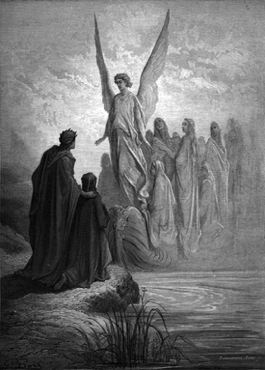Dante on line:
There is a vast quantity of Dante-related material on line. One location to start might be the Princeton Dante Project, which has all of Dante's writings (the Comedy, of course, but also De Monarchia, the Convivio, and even the Questio de aqua et terra) in the original Italian or Latin as well as readable English translations. When you read the Comedy at their site, off on the left hand side you will find a bewildering array of annoyingly small colored dots. The bright red ones will give a brief but useful commentary, while the orange ones give useful notes on Dante's Medieval Italian for students reading in the original but puzzled by ché, fia, and other older forms (it also includes notes on the various manuscripts). You can also listen to the whole thing in Italian, and then read along, or in English if you are visually impaired. Many (all?) of the Doré images as well as a few others are linked as well, and there are multimedia resources, such as contemporary maps, tables and family trees.
The Dartmouth Dante Project is a database of commentaries intended for scholars, but their Next Generation Reader is perhaps of more interest to students. Attractive and legible, it offers the text of the Comedy in Italian, a variety of translations, and a commentary, all visible at the same time (better still, you can choose what you see and resize the windows accordingly, so you can read English and commentary, Italian and commentary, or all three at once). The commentaries run from 1322 (written by Dante's son, Jacopo) to two written just in the last decade, one by Robert Hollander (a Princeton professor) in English, the other by Nicola Fosca (a professor from Turin) in Italian—the list includes what was for many decades, and perhaps still is, the standard commentary on Dante in English, that of Charles Singleton. In other words, if you wish to understand Dante, you have seven hundred years of scholars at your fingertips to help you.
Dante Online is an Italian-language only site, but of some interest are the (moderately) high definition scans of the original manuscripts of the Comedy.
World of Dante at the University of Virginia is more multimedia-based, with text and translation, of course, but also maps, illustrations, manuscripts, music that is mentioned in the Comedy (note at once that there is no music in Hell), an excellent timeline of history surrounding Dante and his life, and more. This isn't perhaps the best on-line venue for reading the Comedy, but it is a great spot to go to for context.
Columbia University hosts Digital Dante, with an extremely appealing "illuminated manuscript" interface, which has a very legible commentary on each canto of the Comedy, illustrations from early print editions of the poem, and a curious intertextual tool that allows one to simultaneously read Dante matched up against relevant passages in Ovid (in the original Latin, natch)—this last bit is probably not for most students.
The many, many excellent illustrations of Dante can be found all over the web, but rarely all in one place. Happily, all of Blake's watercolors can be found at the Blake Archive. Many, although not all, of the famous Doré engravings to illustrate the Comedy can be found at World of Dante (finding a single, complete source of high-quality Doré images has proven elusive for me, however). The number of modern and contmporary illustrations would dwarf any attempt to catalogue them, ranging from contemporary African artists in a gallery show to a series of 100 watercolors by the Spanish surrealist Salvador Dalí. There are infinitely many more films, plays, video games, comic books, science-fiction novels and fan-made art. If anyone has an ancient Macintosh running System 9, I probably have a floppy disk somewhere with a HyperCard stack of Dante's Inferno that I started working on around 1989, back when I was an undergraduate.
Lastly, Bowdoin's Dante Today collects weird and humorous references to Dante from popular culture, ranging from San Francisco restaurants, full-body Inferno tattoos and Dante-themed jewelry to matching Paolo and Francesca teddy bears (Inferno V), a Dante citation in Mad Men, and yes, of course, Dante-themed toilet paper.


